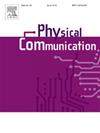关于双跳混合 THz-RF 协同中继网络的性能
IF 2
4区 计算机科学
Q3 ENGINEERING, ELECTRICAL & ELECTRONIC
引用次数: 0
摘要
从理论上讲,0.1-10 太赫兹(THz)频段有可能为 6G 及更高的基础设施提供高数据传输速率。因此,太赫兹频段通信可用于无线光纤扩展器和回程网络。然而,太赫兹波段通信因分子衰减和天线孔径过小导致的天线不对准造成的指向误差而受到严重损失。不过,合作通信策略在增强太赫兹链路方面具有相当大的潜力。此外,要解决太赫兹链路的局限性,必须融合各种技术。因此,在本文中,我们考虑了一种基于解码和前向(DF)的太赫兹射频(RF)混合合作系统模型。此外,我们还对相干正交幅度调制和非相干调制方案进行了深入探讨。我们推导出了端到端 (e2e) 中断概率 (OP)、矩产生函数 (MGF) 和信道容量 (CC) 的精确表达式,以及相干和非相干调制方案的精确平均符号错误率 (ASER) 表达式。我们还进行了渐近分析,以确定系统的分集增益和编码增益。此外,我们还进行了全面的性能分析,以研究各种参数对 e2e 性能的影响。最后,通过蒙特卡洛模拟进行验证,确保了系统的准确性,从而有助于提取实用的设计原则,优化 THz-RF 合作系统。本文章由计算机程序翻译,如有差异,请以英文原文为准。
On the performance of dual-hop mixed THz-RF cooperative relay networks
The 0.1–10 terahertz (THz) band theoretically offers the potential to provide high data rates for 6G and beyond infrastructure. Consequently, THz band communication can be utilized in wireless fiber extenders and backhaul networks. Nonetheless, THz band communication suffers significantly from losses due to molecular attenuation and pointing errors, which result from antenna misalignment caused by small antenna apertures. However, cooperative communication strategies exhibit considerable potential in enhancing the THz link. Additionally, to address THz link limitations, a blend of technologies is necessary. Therefore, in this paper, we consider a decode-and-forward (DF)-based mixed THz-radio frequency (RF) cooperative system model. Furthermore, an in-depth exploration of coherent quadrature amplitude modulation and non-coherent modulation schemes is undertaken. Exact expressions for end-to-end (e2e) outage probability (OP), moment generating function (MGF), and channel capacity (CC) are derived, along with exact average symbol error rate (ASER) expressions for both coherent and non-coherent modulation schemes. We also perform asymptotic analysis to determine the system’s diversity gain and coding gain. Moreover, we conduct a thorough performance analysis to examine the impact of various parameters on e2e performance. Finally, validation through Monte-Carlo simulations ensures system accuracy, facilitating the extraction of practical design principles for optimizing THz-RF cooperative systems.
求助全文
通过发布文献求助,成功后即可免费获取论文全文。
去求助
来源期刊

Physical Communication
ENGINEERING, ELECTRICAL & ELECTRONICTELECO-TELECOMMUNICATIONS
CiteScore
5.00
自引率
9.10%
发文量
212
审稿时长
55 days
期刊介绍:
PHYCOM: Physical Communication is an international and archival journal providing complete coverage of all topics of interest to those involved in all aspects of physical layer communications. Theoretical research contributions presenting new techniques, concepts or analyses, applied contributions reporting on experiences and experiments, and tutorials are published.
Topics of interest include but are not limited to:
Physical layer issues of Wireless Local Area Networks, WiMAX, Wireless Mesh Networks, Sensor and Ad Hoc Networks, PCS Systems; Radio access protocols and algorithms for the physical layer; Spread Spectrum Communications; Channel Modeling; Detection and Estimation; Modulation and Coding; Multiplexing and Carrier Techniques; Broadband Wireless Communications; Wireless Personal Communications; Multi-user Detection; Signal Separation and Interference rejection: Multimedia Communications over Wireless; DSP Applications to Wireless Systems; Experimental and Prototype Results; Multiple Access Techniques; Space-time Processing; Synchronization Techniques; Error Control Techniques; Cryptography; Software Radios; Tracking; Resource Allocation and Inference Management; Multi-rate and Multi-carrier Communications; Cross layer Design and Optimization; Propagation and Channel Characterization; OFDM Systems; MIMO Systems; Ultra-Wideband Communications; Cognitive Radio System Architectures; Platforms and Hardware Implementations for the Support of Cognitive, Radio Systems; Cognitive Radio Resource Management and Dynamic Spectrum Sharing.
 求助内容:
求助内容: 应助结果提醒方式:
应助结果提醒方式:


